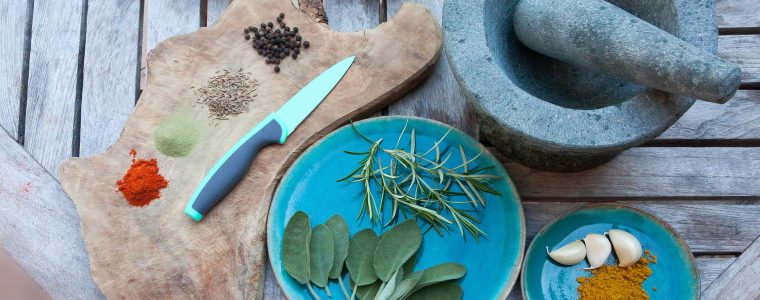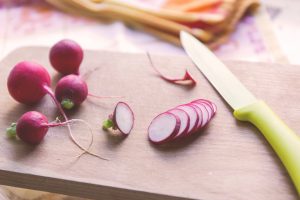
Let’s Talk Ceramic Knives!
Hello again and thank you so much for visiting myelectricknifesharpener. Today I’d like to put to bed a question I’ve seen on numerous forums time and again: Do you sharpen ceramic knives or discard them when blunt?
For those of you who have ever seen or used a ceramic knife, you know immediately that it is nothing like a traditional steel knife. Majority of ceramic knives are composed of a material called Zirconia. One of the common attributes of Zirconia is its hardness and strength. It’s these properties that allow ceramic knives to retain their cutting edge for far longer than the traditional metal knives. For those of you who like to get technical, Zirconia is about 8.2 on the Mohs Scale of Mineral Hardness (Steel is 5-6 and Diamond is 10).

I will not spend much time discussing the technical details, but I am sure by now you have an idea of why sharpening ceramic knives can be so tricky and difficult. Here’s a hint: the process of sharpening a traditional metal knife involves (typically) passing it multiple times against a harder, stronger, tougher abrasive (such as Diamond). More on this below!
The Challenge With Sharpening Ceramic Knives…
Continuing from the hint I left you with above, i’d like to explain in this section why sharpening ceramic knives can be such a challenge. Knife sharpening is basically the process of passing a softer material (steel usually) against a harder, stronger abrasive material. As a result, the harder material i.e. the abrasive, removes or abrades the softer material i.e. the steel. This is what gives you a more defined, sharper edge. That’s all nice and good, but let’s consider a hypothetical scenario for a moment here……
What if in the above instance you had a ceramic knife in place of the traditional steel knife. Would you be able to sharpen a ceramic knife in the same way? Are there any exceptions?
Hmmm….here’s where it gets interesting! The answer to this question is yes, but there are exceptions. You can only sharpen a ceramic knife if the abrasive used is actually harder and stronger than the ceramic itself (remember Mohs hardness scale?). You need to be very cautious when searching for sharpeners that can work on ceramic knives.
Word of caution: Many of you will google search or amazon search “ceramic knife sharpeners” and the results you see could be very misleading. You would likely see results of knife sharpeners that have ceramic material being used as an abrasive. You would then try to sharpen ceramic with ceramic, and the result will not be pleasing!
So Do You Sharpen Ceramic Knives With A Specific Sharpener Or Send Them To A Sharpening Service?
We are now getting to the crux of the problem. You have a couple of options to consider here, and they will depend on how much your ceramic knives are worth.
If you own a cheap set of ceramic knives that cost you $20 or less, you’d be better off not doing anything with them at all and discarding them when they become blunt or have nicks. It’s not worth purchasing a sharpener or sending the knives to a professional sharpening service.
If you own an expensive set of ceramic knives, then you will want to either consider sending them to a professional or investing in a sharpener that is capable of not only sharpening your knives, but also removing nicks and chips. Ceramic knives are brittle and because of this, nicks, chips, and imperfections are quite common and sometimes hard to avoid. Be very cautious/wary of what you see online when searching for knife sharpeners that can do ceramic knives. I would suggest you avoid knife sharpeners that use carbide or ceramic abrasives entirely. I would only ever consider a diamond abrasive to sharpen ceramic knives. If you’ve decided to go the sharpener route, and are wondering how do you sharpen ceramic knives, I strongly suggest you check out the video below from Doug Holser. Watch it right now and only then continue!
What did you think of the video? Pretty informative right! The sharpener that Doug talks about is one that I have reviewed previously. Click here to check out my review!
Okay, but what if you didn’t want all the hassle with sharpening? Well, in that case you could always get a professional to do it. If you do opt to follow this route, I would strongly suggest you do your homework and research all the available sharpening services in your area. Be sure to ask specifically about sharpening ceramic knives, and obviously be sure to find the best price! Important: If you own Kyocera ceramic knives, you are in luck because Kyocera offer lifetime sharpening for all their cutlery (excluding shipping and handling).
Final Words & Recommendations
So there it is! Do you sharpen ceramic knives or discard them when blunt? It really depends on how expensive your knives are and if they’re even worth sharpening. Before I end this post I would like to provide you with two recommendations of ceramic knives.
Recommendation 1: Kyocera Advanced Ceramic Revolution – 3 Piece Knife Set
***CLICK HERE TO CHECK IT OUT ON AMAZON***
One of the more expensive ceramic knife sets you can find, but the money is well worth it! This set of 3 (chef, micro-serrated, and paring knife) is blazing sharp, and seems to retain the same cutting edge for years! If you ever did have imperfections on it, simply send it back to Kyocera as part of their lifetime sharpening program (see above).
Recommendation 2: Cuisinart Advantage Set of 6 Knives (Including Covers)
***CLICK HERE TO CHECK IT OUT ON AMAZON***
This is a cheaper alternative to the Kyocera knives, and they come with different style blades, all including knife covers. This is an example of a set I would not sharpen. It’s simply not worth the investment of a sharpener or paying a professional service. Simply replace them with a new set!
Thanks so much for reading this post and as always, I’d love to read your comments, so please let me know what you think below…..Do you sharpen ceramic knives or throw them out? I’d also love to know what ceramic knives have worked for you…….your recommendations will be useful to everyone, so please share your knowledge! Also, in case you didn’t know, I write reviews of both electric and non electric knife sharpeners. You can check them out by clicking the links.



My wife recently bought a set of the Kyocera ceramic knives and I am very impressed with them. Using a knife has never been so fun! They can cut and slice through anything. And yes, the fact that they have a lifetime sharpening program means I don’t need to invest in a knife sharpening system. One thing I wanted to ask is how long can these ceramic knives typically remain sharp for?
Owain,
Thanks for leaving a comment and reading my post. The ceramic knives will typically retain their edge (without losing sharpness) for much longer than the traditional steel knives, simply because of the toughness and strength of the ceramic (zirconia). Now, it also depends on how you maintain and care for your knives. There are certain foods that you should avoid using your ceramic knife for e.g. squash, pumpkin, frozen foods etc. Below is a little excerpt about wear from Kyocera. Finally, here is a link that will show you how to care for your knives http://kyoceraadvancedceramics.com/use-care/
WEAR:
All knives dull over time. A soft metal blade (stainless steel) “rolls” as it becomes dull. Harder metals (such as high carbon steels, titanium, or carbide) hold their edge longer, but dull differently. As the material hardens, it becomes less forgiving and tends to slightly chip instead of roll. Advanced ceramic blades are simply the next and final step on this hardness scale as it is harder than any metal.
Ceramic starts out sharper–and stays sharper–longer. In time, you may notice micro abrasions or nicks on the blade’s edge. This is the normal process by which any hard material blade will dull. The existence of microchips does not necessarily mean the knife is dull. You will find that it performs well for quite some time. When the knife becomes too dull to use, Kyocera’s sharpening process will “flatten out” the edge of the blade (removing all chips) and then reestablish a new sharp edge. Larger chips and broken tips can often be corrected by sharpening as well.
I had no idea that ceramic knives were composed of zirconia and that it ranked 8.2 out of 10 on Mohs scale of hardness. I do agree that you are going to need a harder abrasive like diamond to sharpen them properly especially if they are an expensive set of knives.
It’s good Kyocera stand behind their product and offer you lifetime sharpening on all your cutlery, but what puzzles me is that if zirconia is so hard, how is it so brittle that it gets all those nicks, chips and other imperfections?
Adrian,
That is an excellent question! It took me a moment to think and formulate a response. Read below.
All ceramics are not created equally. What this means then is that different ceramics will have different chemical and physical properties. For example, zirconia has different properties than some of the other ceramics and so on so forth. Here’s the catch: zirconia is not brittle. It’s actually the other technical ceramics you have to watch out for as those are the more brittle ones. This doesn’t mean that your zirconia blade won’t wear, it simply means it has better, more desirable properties in comparison to other ceramics. This is why it’s important to invest in a quality set of knives which you know will serve you well along the years. Here’s a link you should read to give you a better understanding: http://www.azom.com/article.aspx?ArticleID=11082
Thanks for reading, and please let me know if this answers your question. Cheers!
Hi, Interesting read.
When My ceramic knives blunted I simply discarded them. but as you mention in your post they were very cheap knives. I replaced them with steal knives, as I didn’t like the thought of buying an expensive knife I couldn’t sharpen. It would have been nice to know this then, but I am quite happy with my steel knives and whetstone!
Hi Steve,
Thanks for dropping a comment and checking out my post. Nothing wrong with sticking to the gold old steel knives and sharpening with whetstones! All the best! Cheers!
My wife LOVES ceramic knives! We have had ours for years and they still cut super well! How long does it usually take before they need a sharpen?
Hi Dan,
Thanks for reading my post and dropping a comment. Ceramic knives are awesome….I couldn’t agree more! To answer your question: please refer to my response to Owain here in the comments section (he asked the same question). If you require further clarification, please let me know! Cheers!
Hi! Really interesting read. My Dad has a ceramic knife that he absolutely swears by and you’re right that thing is bloody sharp. What I would like to know is weighing in cost, would it be better to buy cheaper ones and replace them when needed? Or would a more expensive one be more economic? I guess what I’m asking is, what is the life-span for each knife before it gets blunt?
Kate,
Thanks for reading my post and taking the time to drop a comment. There is no “right” answer to your question, but I can definitely share with you what I would do. As with most things you purchase today, quality comes with a price tag. I am totally about finding great deals (and there is nothing wrong with that), but I will not do so at the cost of quality. If you purchase a decent set (like some of the Kyocera’s), then you don’t have to worry about sharpening at all since its offered for a lifetime. To answer your question of how long it will take before the knife loses its edge, refer to my response to the comment posted by Owain. If you require further clarification, please let me know! Cheers!
Informative post, thanks for sharing. I am in search for a good set of ceramic knives, and being aware of some of the things you have pointed out in the post e.g. lifetime sharpening, will make my decision more easier. If I have any specific questions down the road, I’ll send you an email or comment on your post.
Jed,
Thanks for reading and dropping a comment. Feel free to reach out to me with any questions you may have. Cheers!
I have just nicked the cutting edge of a Farberware ceramic knife. It’s quite small, between a 32nd and a 64th of an inch deep. Will the edge now continue to break down and if so, should I toss it (with care, wrapped up before put into trash)?
Thanks for sharing a comment! The answer to your question is it really depends on how much the knife costs. If it’s inexpensive, I’d use it till I no longer can and then toss it out and buy a new one. When you’re buying a new ceramic knife, make sure you consider Kyocera! They make some really solid/tough knives. Does that make sense? Please let me know if it doesn’t, so we can figure out what can be done to resolve your situation. Cheers!